Famous for its spicy, tongue-numbing, savory, delicious, oily, and heavily seasoned flavors, Sichuan cuisine is the most popular regional cuisine in China. (Check it out: Eight Culinary Traditions of Chinese Cuisine) As one of China’s four main styles of cooking, Sichuan cuisine enjoys a time-honored history and reputation. Even in restaurants that don’t specialize in Sichuan cuisine, you’ll see some classic Sichuan dishes on the menu.
Even if you’ve never had Sichuan food before, these names may sound familiar, like mapo tofu and kung pao chicken. But Sichuan cuisine is not just about the face-melting heat and spices. To understand Sichuan cuisine, one must understand its history, characteristics, and geography.
In this article, we are going to explore all aspects of Sichuan cuisine. You’ll learn what makes Sichuan food special, why Sichuan chefs prefer to use spices, the history behind it, and some famous must-try Sichuan food when you dine out next time in a local Sichuan restaurant.
The History of Sichuan Cuisine
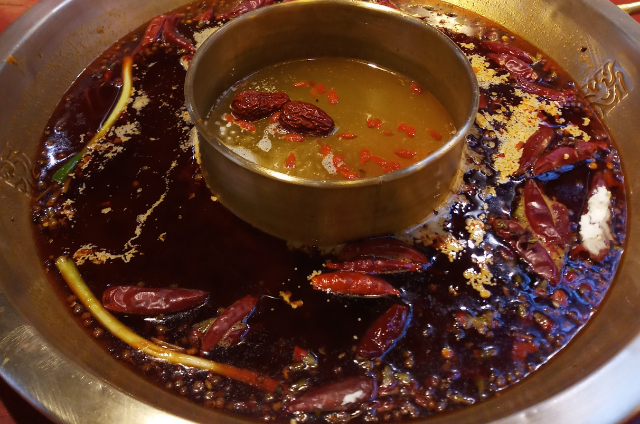
Back to the Chinese Qin and Han dynasties (221BC-220AD), Sichuan cuisine reached fame 800 years ago and has been enjoyed by royals and commoners in China. Many Sichuan restaurants were opened in Lin’an, now called Hangzhou, the capital of China back then. Due to its unique flavor, Sichuan cuisine has become more and more popular and enjoyed the same reputation as Shandong, Guangdong (Canton), and Huaiyang cuisines. Sichuan cuisine became popular in other parts of the country in the late 1990s. Chain restaurants started opening up and became trendy spots for a fun night out. This popularity is one key to the cuisine’s expansion outside China.
Sichuan province is located in southwestern China, it has historically been seen as a “land of abundance” or “heavenly country” due to its climate and geography. The Sichuan basin is flanked by mountains on all sides and the vast Qinghai-Tibet plateau to the west, making it so difficult to reach. Fertile soil and a warm, wet climate have impacted the robustness of its agriculture, and in turn its cooking. Because of its abundance of food and natural resources, such as garlic, ginger, and chili peppers, Sichuan cuisine features well-arranged and enriched seasonings. Sichuan has many rainy or overcast days. Chinese people believe that consuming spicy food can help the body get rid of the humidity. This is the most common reason why Sichuan people prefer spicy food.
Why is Sichuan Food So Famous?
Sichuan cuisine has been conquering the world. It has become the top choice for out-of-home dining. Countless restaurants that claim to be authentic Sichuan restaurants, and you can even buy pre-packaged seasoning from Asian grocery stores for dishes like water-poached fish(Shui zhu yu), Sichuan Fish with Pickled Mustard Greens (suan cai yu), and mapo tofu (Mapo Tofu Recipe). Sichuan cuisine has become one of the most successful cuisines in big cities like New York, London, and other intensely competitive dining cities abroad.
Since the late ’90s, Americans’ palates got ready for the new flavors this culinary tradition has to offer. Americans are curious about these exotic dishes and flavors. They yearn for something new, something different than the 24/7 fast-food restaurants. The heat and umami qualities in Sichuan cuisine happen to align well with American food preferences. Comfort and informality are two of the leading trends in American dining today. People are craving more casual experiences and more homey cooking. Sichuan cuisine fits in perfectly here.
What makes Sichuan cuisine so special and famous? “Each Sichuan dish has its own style — a hundred dishes have a hundred different flavors”. This perhaps speaks best to the delicious flavors and diversity of Sichuan food. Sichuan food is different than any other cuisine because it is really about a variety of flavors, not just one or two. You’ll experience salty, sour, spicy, flowery, sweet, smoky, and bitter. The authentic Sichuan dishes are a symphony, while fake ones only hit one note at a time. Sichuan cuisine is truly one-of-a-kind. Sichuan food lingers on the senses. You feel the intensity and depth of the flavors sink in and permeate the stomach and mind over time.
Sichuan cuisine translates well to people outside of Sichuan Province, and it is easily reproduced. Its unique flavor profiles help the cuisine travel well. People don’t need one particular ingredient to recreate the flavors. The unquestionable identity can be realized with many ingredients and in many ways. That’s the beauty of Sichuan food and another reason why it is so famous.
What Are The Characteristics of Sichuan Cuisine?
There are “seven flavors” and “eight tastes” in Sichuan cuisine. The “seven flavors” are
- Sweet
- Sour
- Numbing
- Spicy
- Bitter
- Fragrant
- Salty
And the “eight tastes” are
- Málà wei
- Fish fragrant (yu xiang wei)
- Mouthwatering (kou shui wei)
- Strange flavor (guai wei)
- Spicy sesame
- Garlic paste flavor (suan ni wei)
- Wine fragrant
- Scorched chili flavor
“Aromatic spicy” (xiangla) and “numbing spice” (mala) are the most famous types of spice in Sichuan food. People often compare Hunan food with Sichuan food since they are both spicy. However, they are quite different from each other in terms of spiciness. Hunan chefs like to cut lots of chili peppers into small pieces then add them to the dish. As a result, the dish is purely spicy and hot. Sichuan’s kind of spiciness is different. It smells good because there are many ingredients besides chili peppers and is actually not that spicy. Some people say that eating Sichuan food can really stress relieving and make them happy. Sichuan chefs are famous for combining a limited number of ingredients to form at least 24 compound flavors known as fu he wei, flavors that extend beyond just “spicy”.
“Aromatic spicy” (xiangla) and “numbing spice” (mala) are the most famous types of spice in Sichuan food. Compared to other cuisines known for their hotness in China, some diners perceive Sichuan spiciness as a mellower, and therefore easier to digest for those who did not grow up with spicy food culture.
What Food is Sichuan Known For?
- Hot Pot (huo guo)

Originated in Chongqing, the Sichuan hot pot was originally made with buffalo meat and hot spices to help workers drive the dampness of the winter cold away. It was such an economical and satisfying dish that it quickly became popular. Hot pot chain restaurants like Haidilao emerge and make the hot pot famous around the globe.
Nowadays, hot Pot is more than a dish to Sichuan people; it is a way of life. It’s a wonderful way to celebrate family reunions, friend get-togethers, and holidays. Everyone sit around a bubbling pot of spicy soup with chili peppers, lard, and spices for hours. It requires the preparation of a soup base, dipping sauce and some meat and vegetables to pair with the hot pot. Some common ingredients are:
- Thinly shaved beef or lamb
- Fishball
- Tofu sheets or sliced firm tofu
- Fried tofu puffs
- Fresh or dried noodles
- Glass noodles
- Chinese rice cakes
- Greens (bok choy, lettuce, napa cabbage)
- Woodear or mushroom
However, the main thing separating Sichuan hot pot from other versions is its soup base, which is a complex layering of flavors built upon a base of rich beef tallow, fermented fava-bean paste, and chili oil, and up to a dozen spices and herbs are thrown in as well.
- Mapo Tofu (ma po dou fu)
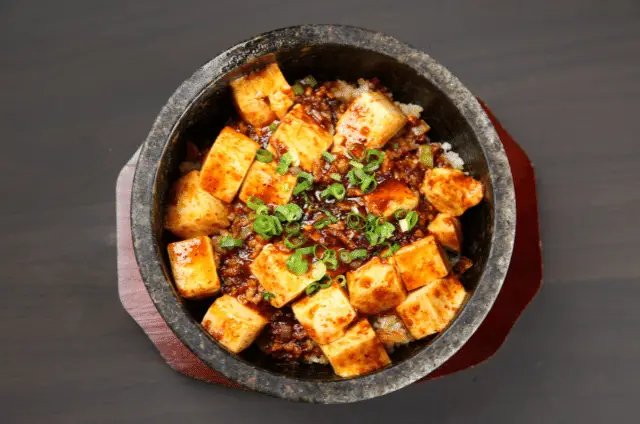
Mapo Tofu is a popular Sichuan dish, hence it’s quite spicy. The Sichuan Peppercorn gives the dish a unique “numbing” effect. The name of the dish roughly translates to “pockmarked grandma’s tofu.” It is one of the most famous tofu recipes in China. This spicy, delicious dish usually includes a small amount of ground pork. But ground pork is totally optional if you want a vegan version.
You can find mapo tofu in restaurants all over China, but it’s hard to get that authentic, Sichuan flavor just right. So it’s even harder to find authentic Ma Po Tofu in the United States. Even though the ingredients are cheap, mapo tofu is seen as a test of any aspiring chef’s skills.
- Dan Dan Noodles (dan dan mian)
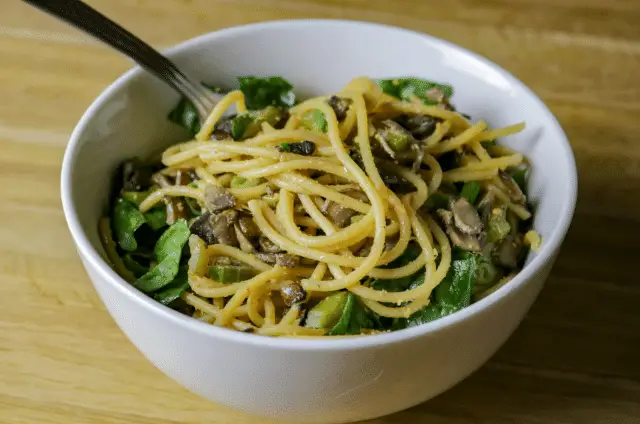
Dan Dan Noodles are a famous Sichuan street foods. Considered as a snack, it’s usually served in a small bowl. The freshly boiled thin noodles are served in a savory, spicy sauce topped with crispy pork and peanut flakes. Dan Dan Noodles have three parts: 1) A thick sauce (made of black rice vinegar, chili oil, Chinese sesame paste, ground Sichuan peppercorns, and soy sauce) which delivers a distinctive nutty, numbing taste. 2) Delicious toppings (including fried minced meat, preserved vegetables & fried peanuts or soybeans) 3) Plain wheat flour noodles. If you want a healthier meal, you can top the noodles with some leafy green vegetables.
- Chicken in Red Oil Sauce (kou shui ji)
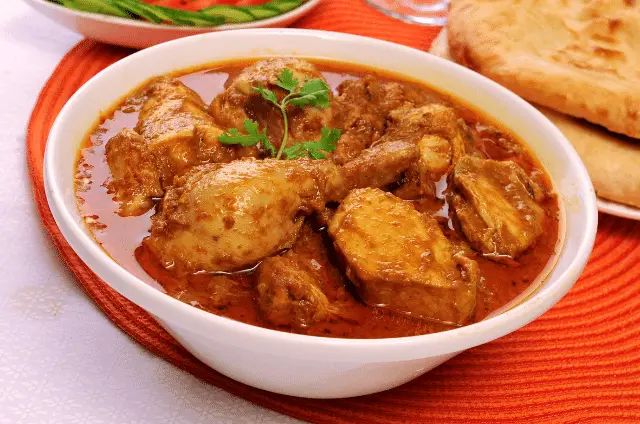
Chicken in red oil sauce is literally translated to “saliva chicken” in Chinese, but the real meaning behind it is “mouthwatering chicken”. The juicy chicken is smothered in a thick, red-oil-based sauce. Traditional mouth-watering chicken calls for a whole chicken served chopped with skin and bones. If you cook at home, chicken thighs and chicken wings are good options too. The short poaching cooking skill makes the chicken meat super tender and it is also used in Cantonese white cut chicken.
The main ingredient which makes this dish shine is the hot and super aromatic chili oil. Like any classic Sichuan dish, this one also has a sophisticated, multi-layered taste: garlicky, gingery, umami (from the fresh chicken stock), savory (from soy sauce), sour (from Chinese rice vinegar), sweet, nutty (from peanuts & sesame) and mouth-numbing (from Sichuan pepper).
- Sichuan Fish with Pickled Mustard Greens (suan cai yu)
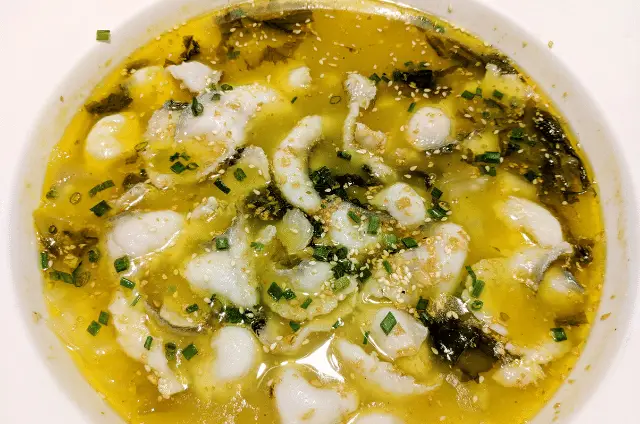
As a sister dish to Sichuan-style water-boiled spicy fish, suan cai yu is a great dish that you will find really comforting and satisfying on a chilly day. It’s a fragrant and spicy fish stew with thinly sliced and poached fish fillets in a rich broth with pickled mustard greens (called “suan cai”). Suan cai is used to impart the “sour” part of the flavor. It’s usually available at Asian grocery stores near the refrigerated section. The flavor is a little bit sour like sauerkraut, but it has the flavor of greens. The dish is topped with dried red chiles and golden flower petals, mostly for color, and a sprig of fragrant green Sichuan peppercorns.
- Kung pao chicken (gong bao ji ding)
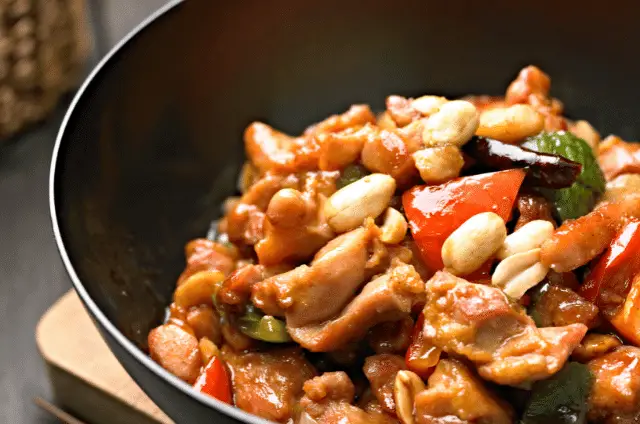
As one of the most well-known Chinese dishes, Kung Pao Chicken combines the savory and a mild spicy taste with the nutty flavor from the peanuts. It consists of fried and breaded chicken, fried peanuts, hot chilies, Sichuan peppers, and vegetables. It is an authentic Sichuan dish of chicken breast, cut up and stir-fried in “Kung Pao sauce”, which includes soy sauce, vinegar, and a bit of sugar.
It’s traditionally made with specialty ingredients, like Sichuan peppercorns, Chinese black vinegar, Chinese rice wine, and whole dried red chilies. If you like a bit sweet and sour taste and don’t mind a punch of heat in one plate, then Kung Pao Chicken is right for you!
The dish is loaded with fat, saturated fat, cholesterol, and sodium, but it does offer significant amounts of some essential amino acids and certain vitamins and minerals.
- Twice-cooked pork (hui guo rou)
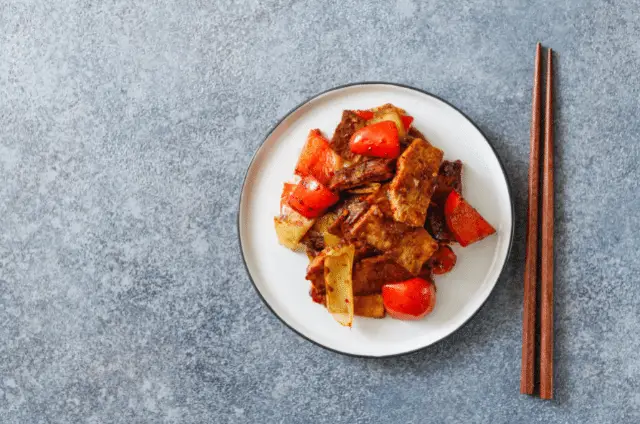
Twice-cooked pork, also known as Hui Guo Rou, literally means “the meat that returned to the wok”. The meat specifically refers to pork belly. The name clearly explains the special two-step cooking method. First, simmer a chunky piece of pork belly in water then cut it into slices. Then return the cooked pork to a wok and stir-fry with vegetables and seasoned with condiments. This cooking method gives the dish a delicious, complex texture.
The key flavor of this dish is fragrant and spicy, which comes from two versatile ingredients: chili bean paste and fermented black beans. The pork belly doesn’t taste greasy when combined with these condiments, and some fat is removed during the boiling and stir-frying process.
- Dry-fried string beans (gan bian dou jiao)

Unlike the traditional string bean recipe with mushy beans and flavorless sauce, this dry-fried string bean is completely different. It requires less oil but a longer stir-frying time, to create a crispy and charred surface on the vegetables. The dry-fry method causes the vegetables to release moisture slowly. The texture of dry-fried green beans is similar to that of grilled ones, with a hint of smoky flavor. Seasonings such as soy sauce, dried chili peppers, and Sichuan peppercorns are added after dry-frying. Other ingredients are tossed together, such as ground pork, ginger, and garlic. This dish has an intense flavor, usually pretty spicy and super garlicky, without adding a lot of sauce.
- Water-poached fish (shui zhu yu)
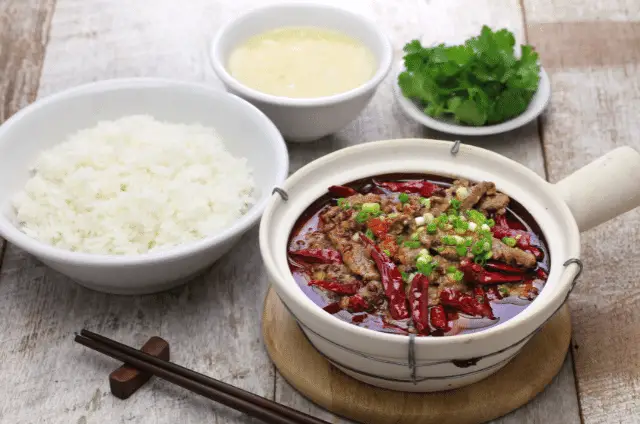
Sichuan boil fish literally means “Shui Zhu Yu” (meaning water boiled fish). However, it is far more than that. It is the opposite of the typical idea of “boiled” you might have in mind. It is super intense, super spicy, and super fragrant.
In China, restaurants often have customers choose live fish from the fish tanks and freshly prepare this dish. It is famous for its hotness. It delivers an intensive numbing sensation to your mouth by using quite a lot of Sichuan pepper. If you are a seafood fan, you should try this addictively tasty dish.
- Sichuan Eggplant with Yu Xiang Sauce (yu xiang qie zi)
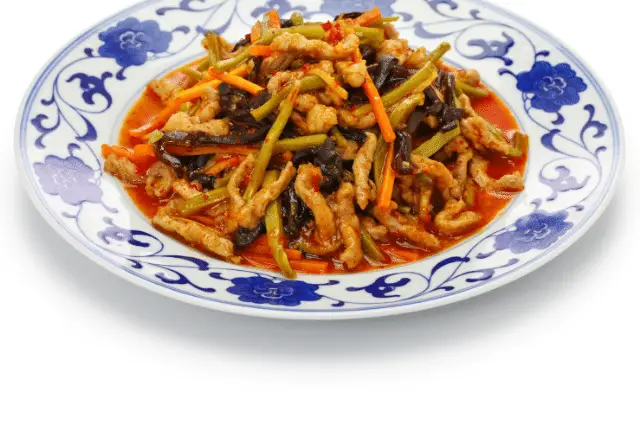
“Yu Xiang” actually means fish-fragrant, which is a kind of flavor quite famous in Sichuan dishes. Yu Xiang Qie Zi is a sister dish to another famous Sichuan dish, Yu Xiang Rou Si (fish-fragrant shredded pork). However, fish-fragrant eggplant has nothing to do with fish. It’s a stir-fry dish consisting of eggplant pieces, minced meat, pickled chili, and a multi-layered thick sauce.
Yu Xiang flavor is one of the seven key flavors in Sichuan cuisine. It contains soy sauce, Chinkiang vinegar, sugar, fermented spicy bean paste, chili peppers, fresh garlic, ginger, and onion. The sauce is well-balanced, sweet and sour spicy, similar to General Tso’s sauce.
- Mala Chicken (la zi ji)
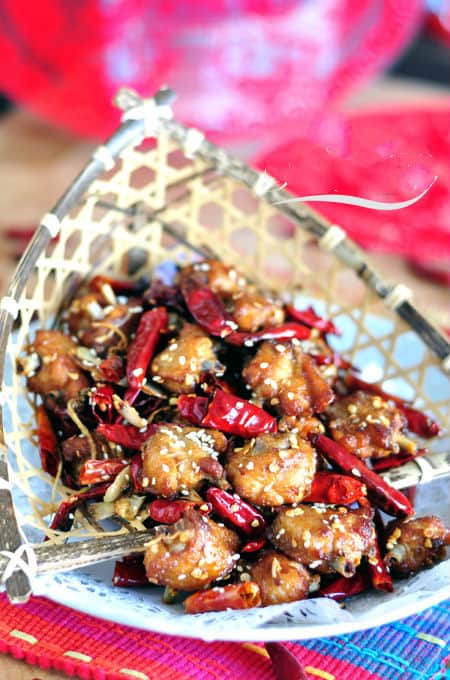
Sichuan Mala Chicken is another classic in Sichuan cuisine – spicy, yet well-balanced. In this chicken dish, the unique and well-balanced flavor comes from a few key ingredients: chili peppers, the numbing tingling Sichuan peppercorns, sesame seeds, aromatics, salt, and sugar. This dish isn’t as spicy as it looks. Unlike the tear-inducing Thai-style spiciness, the heat level in this dish is only considered medium, as other condiments add additional layers of flavor.
So don’t be fooled by the display of a mountain of peppers on top of the chicken. It’s quite different from what you see.
- Sliced Beef in Chili Sauce (fu qi fei pian)
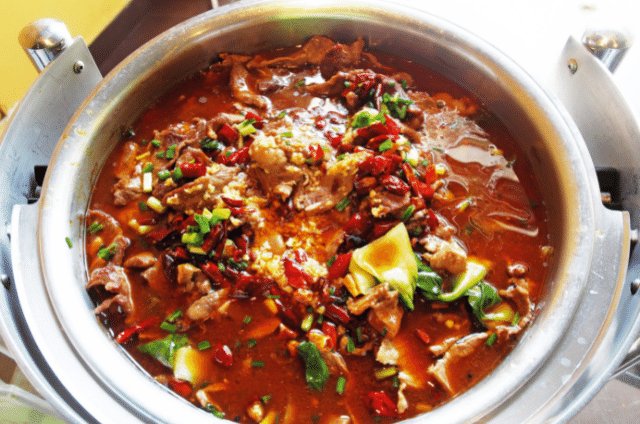
Sliced beer in chili sauce is one of the most underrated dishes outside of China. It can be literally translated to “Husband and Wife Lung Slices”. Admittedly, this is a weird name. But rest assured, this dish doesn’t contain a lung. It is usually made with the cheapest cuts of the beef available, such as brisket, plus some offal, such as tripe, heart, or tongue. These offal parts are cheaper and can create a mixed texture of tender and crunchy. The tender beef slices are served in a rich, spicy hot sauce and topped with peanut flakes and cilantro.
